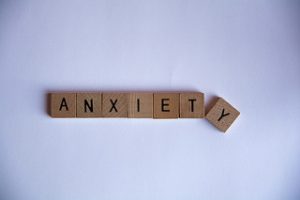 Anxiety disorders are characterized by extreme fear, nervousness, or worry on exposure to a feared stimulus, which can be an object, person, or situation. Fear is differentiated from anxiety, in that fear is a reaction to a current stimulus, whereas anxiety is fear of some future stimulus or anticipation of one. Anxiety becomes a problem when one becomes fearful, nervous, or worried out of proportion to the feared stimulus, or becomes nervous or worried about some future stimulus or anticipated event.
Anxiety disorders are characterized by extreme fear, nervousness, or worry on exposure to a feared stimulus, which can be an object, person, or situation. Fear is differentiated from anxiety, in that fear is a reaction to a current stimulus, whereas anxiety is fear of some future stimulus or anticipation of one. Anxiety becomes a problem when one becomes fearful, nervous, or worried out of proportion to the feared stimulus, or becomes nervous or worried about some future stimulus or anticipated event.
Fear is a normal response, and is a necessary component of survival. When presented with danger in the environment, a physiological reaction is triggered where adrenaline is released into the bloodstream. Adrenaline is a fear-response hormone which causes several physical changes in the body, including increased heart rate, increased rate of breathing, and dilated pupils. In addition, there is shunting of the blood flow from the digestive system and the skin to the skeletal muscles, which can be felt as having the “butterflies” in the stomach or having numbness and tingling sensations of the extremities. These physical changes allow the person to prepare to fight the danger, or to run from it, the so-called “fight-or-flight” response. The increased heart rate and breathing rate allows the blood to supply more oxygen to the skeletal muscles needed to fight or run, and the blood shunting to the skeletal muscles further aids this process. The dilated pupils allows for improved vision to assess the danger, and the brain becomes more alert and hypervigilant for danger, allowing one to scan their environment in order to deal with the external danger. However, this fear response goes awry when one starts to anticipate danger, or starts to have thoughts about events which overestimate the danger and underestimate one’s ability to cope with the danger. In this situation, the fear response is heightened by one’s thoughts about the event or future event, where the overestimation of danger and underestimating of one’s coping leads to anxiety. Unfortunately, the body perceives fear and anxiety the same way, where the adrenaline response is triggered with either fear or anxiety. So when one has anxiety, the fight-or-flight response is activated, and serves no purpose as the danger is more in one’s head and the way they think or give meaning to the situation.
Anxiety becomes an anxiety disorder when the anxiety symptoms cause impairment of functioning in relationships and work/school, and the person has significant distress and is unable to control the anxiety. The major anxiety disorders include generalized anxiety disorder, specific phobia, social phobia, panic disorder, post traumatic stress disorder, and obsessive compulsive disorder. Other anxiety disorders include substance induced anxiety disorder, anxiety due to a general medical condition, acute stress disorder, adjustment disorder with anxiety, separation anxiety disorder, and selective mutism. Each disorder is associated with a specific core anxiety symptom:
- Generalized anxiety disorder- generalized worries
- Specific phobia- fear of an object or situation (ie fear of heights)
- Social phobia- fear of social scrutiny (ie stage fright)
- Panic disorder- panic attacks
- Post traumatic stress disorder- flashbacks and nightmares of trauma
- Obsessive compulsive disorder- intrusive thoughts and ritualistic behaviors
Anxiety treatment involves psychotherapy, with cognitive behavioral therapy (CBT) having the most evidence for efficacy. CBT works on the premise that events or situations do not directly cause the anxiety; rather, the thoughts we have or the meaning we give the events causes the anxiety. CBT works by identifying the maladaptive thoughts, working on more adaptive thoughts, and suppressing/distancing oneself from the maladaptive thinking. In addition, CBT addresses the avoidant behaviors which serve to sustain the anxiety over the long term; this can be a difficult task, as the avoidant behaviors serve to relieve anxiety in the short term. Other forms of psychotherapy include depth or insight oriented psychotherapy, which addresses the causes and the proximal determinants of the anxiety. If psychotherapy is not effective, or if the anxiety symptoms are severe, then pharmacotherapy with anxiety medications can be considered after a psychiatric assessment. Other treatments for anxiety include self-help treatments, natural supplements, and alternative interventions for anxiety like exercise, meditation, and relaxation. Please see AnxietyBoss.com for more information and help on anxiety.
photo credit: PracticalCures Anxiety via photopin (license)








I have a comment on one of your articles. This was the only way that I was able to contact you successfully, so my apologies.
https://anxietyboss.com/how-anxiety-evolves-the-negative-cycle-of-anxiety/
If you don’t mind, I see a flaw within this article. I agree that avoidance behaviors are a type of coping mechanism. However, you must take notice that there are both negative and positive types of coping mechanisms, in which avoidance behaviors fall under the negative.
One can start avoiding some situations to reduce anxiety and distress for a temporal amount of time. However, it is strongly likely that, eventually, these small situations will inevitably start to increase. Once small and deamed insignificant avoidances will escalate into a repetitive cycle, where even situations that are unnecessary to avoid, will be avoided, thus worsening the state of distress previously inhibited.
Once again, to restate, Avoidance Behaviors are under the umbrella of negative coping mechanisms. The way you worded it seemed as if it was neutral, and ineffective to creating future occurrences involving anxiety and inducing stress. It would be helpful to also include the positive forms of coping mechanism that will help one to get through a situation instead of avoiding it completely; such as humming, tapping one’s hands or feet, listening to music, etc.
Thank you.
Thank you for your comment about avoidance and negative coping. I agree with you, that avoidance is a maladaptive coping mechanism.
Good day doc! I’m an Iraq war veteran with PTSD and have a host of sleep disturbances since I left the service back in 2010. I also recently got diagnosed with complex sleep apnea in August 2017. Like many combat veterans, I’m facing an uphill battle with the VA to get sleep apnea service connected as a secondary to PTSD. This is because many VA doctors and veterans know that PTSD aggravates sleep apnea but don’t know how. Even though there is countless of studies suggesting PTSD is prevalent in the majority of combat veterans, 3 out of 4 veterans get denied. I recently came upon your website about anxiety and sleep apneas and it has brought hope into my life knowing that there are outstanding doctors as yourself that understand the “how”. I refer many veterans to your website so that soon the VA will stop denying us. Thank you.
I’m sorry you are having such difficulty getting the VA disability benefits for illnesses you incurred while on active duty. It’s a travesty. My recommendation is to see a psychiatrist who is not connected to the VA…hire one privately, and have that psychiatrist perform an independent evaluation on linking the sleep disorder with PTSD, and linking the time course while you were on active duty. The key is finding a psychiatrist who will go the extra mile to see it through with you until you receive the VA disability benefits that you rightly deserve. Thanks for referring your fellow Veterans to my website, AnxietyBoss.com.
Best Regards,
Dr. Carlo